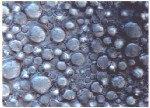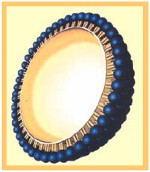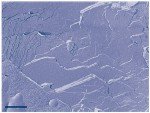When talking of emulsions, we generally understand a mixture of substances which actually cannot be naturally mixed as oils or fats are not dissolving in water.
As both of the substance groups are very useful for the care and cleansing of the skin, already a long time ago people thought about realizing it in some way. Nature itself offers an excellent example: a closer look at milk with the help of microscope shows that fat droplets are suspended in watery surrounding. In times of the ancients already, donkey milk was an indispensable skin care product. There is even more to it: besides skin care, a bath in donkey milk also had cleansing properties. While the milk removes oil-soluble and water-soluble substances from the skin it also supplies the skin with oil-soluble and water-soluble skin care substances.
Now, natural milk is a very complex system where substances like phospholipids and proteins (casein) among others enable the fat droplets to stabilize in the watery whey. These substances especially concentrate at the interfaces of fat and water and thus avoid the merging of the fat droplets ("creaming"). Although they have the same task as today's emulsifiers, whose name derives from the Latin term "emulgere" which means "to milk" by the way, they have a broader variety of functions which, above all, are of physiological nature.
Modern emulsifiers
In comparison, modern emulsifiers rather are additives and generally are classified in the group of the so-called tensides, i.e. substances that reduce the surface tension. Besides the emulsifiers, also the foamers, antifoamers, wetters, cleansers (detergents) and solubilizers belong to the substance group with tenside-like properties. Emulsifiers have a variety of different structures and resulting from those also different fields of application. A major role also plays their concentration.
To add an example: A piece of curd soap practically consists of a pure emulsifier which in combination with water is able to assimilate fats. Hence, curd soap is used for skin cleansing, i.e. the removal of fatty contaminations but also of surplus skin fat. By mixing the same emulsifier with skin care oils, water and aqueous skin care substances, oil-in-water-creams (O/W cream) can be produced.
 Figure: O/W-emulsion (microscope)
These skin care creams have been known for a long time as "stearate creams" and even today they may still be found sometimes with this designation, e.g. with a high percentage of free stearic acid in the skin protection sector. They have been replaced by pure synthetic emulsifiers, which show a lot of advantages concerning their properties.
Skin care and cleansing
Just like the natural milk, emulsions look milky-white and are used for cleansing creams as well as skin care creams (semi-solid) and lotions (liquid). These O/W-emulsions consist of fat droplets of the size of about 1-20µm, which means 0,001 - 0,020 mm. There are also water droplets in oil (W/O creams) or even multiple systems (W/O/W and O/W/O). Generally can be said that O/W creams mostly have moisturizing and W/O creams fat-supplying properties.
Figure: Preparation of emulsions
The smaller the droplet size, the more transparent are the preparations. Emulsions with a droplet size of 10 - 50 nm, which is 0,00001 - 0,00005 mm, also are called micro-emulsions. They are completely transparent and contain a comparatively high percentage of emulsifiers.
Micro-emulsions
Micro-emulsions have different objectives. The high percentage of emulsifiers causes a very fast penetration respectively permeation of the active agents into the skin due to its powerful impact on the skin barrier. This is an advantage especially for the pharmaceutical sector, i.e. when systemic therapies with drugs are intended. In the field of skin care this may rather cause disadvantages as emulsifiers severely disturb the integrity of the skin barrier layers (see KI 2000 (12), 112-113: emulsifiers - looking for alternatives). In the cosmetic sector micro-emulsions are mostly used in skin cleansing, e.g. in form of fat-containing cleansing gels, shower gels and foam bath products.
In the narrower sense, micro-emulsions are highly concentrated tenside systems which actually are no longer emulsions as even with the help of an electron microscope the water and oil phase cannot be differentiated. In isolated cases they are used for transdermally acting drugs, however, due to the side effects of the emulsifier they are of no importance. By contrast, in the field of skin cleansing products there is no longer a clear dividing line between bi- and mono-phase systems.
Emulsifier free products
While emulsions and micro-emulsions rather follow a classical concept, which to a large part is orientated towards synthetic emulsifiers, nano-emulsions rather observe a physiological path. Nano-emulsions deal with particles which still surpass the particle size of micro-emulsions: they have diameters of 0,00005 - 0,0001 mm. Nano-emulsions are not containing the typical emulsifiers but only naturally pure phosphatidylcholine. Phosphatidylcholine is made from lecithin and is the essential element of every single natural cell membrane. Dispersions of phosphatidylcholine spontaneously form bilayer membranes just like those of the cell membranes, the skin barrier layers and of liposomes. By means of high pressure technology phosphatidylcholine can also be forced to form simple membranes, which are able to enclose oil droplets. This results in the fact that there is no longer need for emulsifiers. Similar conditions are realized as they are known of the characteristic fat transport of the body, the chylomicrons.

Figure: Nanoparticle (model)
Phosphatidylcholine can be completely metabolized and additionally supplies the skin with two essential substances: linoleic acid and choline. Consequently, phosphatidylcholine and emulsifiers only have very few things in common. The term nano-emulsion already has been supplemented respectively replaced very early with terms like nanodispersion, nanoparticles and nanoparts. Among other applications, nano-emulsions are used for the intravenous fat nutrition. Using conventional emulsifiers for the same purpose would rapidly lead to a destruction of the blood and blood vessels.
In the cosmetic sector, nanoparticles belong to the group of emulsifier free products. Nanoparticles have an important advantage: While emulsifiers mostly are stored in the skin without any changes, and more or less support a washout of skin-own fats on the occasion of the next skin cleansing, phosphatidylcholine just showed the opposite effect, i.e. an almost magical attraction into the skin. This also applies to the donkey milk mentioned above and is also observed in balneological products.
Due to the high production costs, nanoparticles in a higher dosage are only used in special products, e.g. products for the elderly skin and problem skin as well as products for the supportive prevention.
DMS-creams are neither classified as emulsions as there are no droplet structures to identify under the microscope.

Figure: DMS cream (electron microscope)
Two-dimensional membranes which are also typical for the skin barrier layers are only visible with the electron microscope. Although it is very hard to tell the difference as to the appearance and application of DMS-creams and conventional emulsions, DMS-creams cannot be produced with the conventional emulsifying procedure. DMS-creams are appropriate for specifically sensitive skin and problem skin, as they avoid disorders in the skin barrier.
Dr. Hans Lautenschläger | 
